04、Spring Authorization-自定义设备码授权
代码集成
添加一个authorization包,文件都放在该包下,代码参考官方示例
添加DeviceClientAuthenticationToken
package com.example.authorization;
import java.util.Map;
import org.springframework.lang.Nullable;
import org.springframework.security.core.Transient;
import org.springframework.security.oauth2.core.ClientAuthenticationMethod;
import org.springframework.security.oauth2.server.authorization.authentication.OAuth2ClientAuthenticationToken;
import org.springframework.security.oauth2.server.authorization.client.RegisteredClient;
/**
* 设备码模式token
*
* @author DDKK.COM 弟弟快看,程序员编程资料站
* @author Steve Riesenberg
* @since 1.1
*/
@Transient
public class DeviceClientAuthenticationToken extends OAuth2ClientAuthenticationToken {
public DeviceClientAuthenticationToken(String clientId, ClientAuthenticationMethod clientAuthenticationMethod,
@Nullable Object credentials, @Nullable Map<String, Object> additionalParameters) {
super(clientId, clientAuthenticationMethod, credentials, additionalParameters);
}
public DeviceClientAuthenticationToken(RegisteredClient registeredClient, ClientAuthenticationMethod clientAuthenticationMethod,
@Nullable Object credentials) {
super(registeredClient, clientAuthenticationMethod, credentials);
}
}
添加DeviceClientAuthenticationConverter
package com.example.authorization;
import jakarta.servlet.http.HttpServletRequest;
import org.springframework.http.HttpMethod;
import org.springframework.lang.Nullable;
import org.springframework.security.core.Authentication;
import org.springframework.security.oauth2.core.AuthorizationGrantType;
import org.springframework.security.oauth2.core.ClientAuthenticationMethod;
import org.springframework.security.oauth2.core.OAuth2AuthenticationException;
import org.springframework.security.oauth2.core.OAuth2ErrorCodes;
import org.springframework.security.oauth2.core.endpoint.OAuth2ParameterNames;
import org.springframework.security.web.authentication.AuthenticationConverter;
import org.springframework.security.web.util.matcher.AndRequestMatcher;
import org.springframework.security.web.util.matcher.AntPathRequestMatcher;
import org.springframework.security.web.util.matcher.RequestMatcher;
import org.springframework.util.StringUtils;
/**
* 获取请求中参数转化为DeviceClientAuthenticationToken
*
* @author DDKK.COM 弟弟快看,程序员编程资料站
* @author Steve Riesenberg
* @since 1.1
*/
public final class DeviceClientAuthenticationConverter implements AuthenticationConverter {
private final RequestMatcher deviceAuthorizationRequestMatcher;
private final RequestMatcher deviceAccessTokenRequestMatcher;
public DeviceClientAuthenticationConverter(String deviceAuthorizationEndpointUri) {
RequestMatcher clientIdParameterMatcher = request ->
request.getParameter(OAuth2ParameterNames.CLIENT_ID) != null;
this.deviceAuthorizationRequestMatcher = new AndRequestMatcher(
new AntPathRequestMatcher(
deviceAuthorizationEndpointUri, HttpMethod.POST.name()),
clientIdParameterMatcher);
this.deviceAccessTokenRequestMatcher = request ->
AuthorizationGrantType.DEVICE_CODE.getValue().equals(request.getParameter(OAuth2ParameterNames.GRANT_TYPE)) &&
request.getParameter(OAuth2ParameterNames.DEVICE_CODE) != null &&
request.getParameter(OAuth2ParameterNames.CLIENT_ID) != null;
}
@Nullable
@Override
public Authentication convert(HttpServletRequest request) {
if (!this.deviceAuthorizationRequestMatcher.matches(request) &&
!this.deviceAccessTokenRequestMatcher.matches(request)) {
return null;
}
// client_id (REQUIRED)
String clientId = request.getParameter(OAuth2ParameterNames.CLIENT_ID);
if (!StringUtils.hasText(clientId) ||
request.getParameterValues(OAuth2ParameterNames.CLIENT_ID).length != 1) {
throw new OAuth2AuthenticationException(OAuth2ErrorCodes.INVALID_REQUEST);
}
return new DeviceClientAuthenticationToken(clientId, ClientAuthenticationMethod.NONE, null, null);
}
}
添加DeviceClientAuthenticationProvider
package com.example.authorization;
import lombok.RequiredArgsConstructor;
import lombok.extern.slf4j.Slf4j;
import org.springframework.security.authentication.AuthenticationProvider;
import org.springframework.security.core.Authentication;
import org.springframework.security.core.AuthenticationException;
import org.springframework.security.oauth2.core.ClientAuthenticationMethod;
import org.springframework.security.oauth2.core.OAuth2AuthenticationException;
import org.springframework.security.oauth2.core.OAuth2Error;
import org.springframework.security.oauth2.core.OAuth2ErrorCodes;
import org.springframework.security.oauth2.core.endpoint.OAuth2ParameterNames;
import org.springframework.security.oauth2.server.authorization.client.RegisteredClient;
import org.springframework.security.oauth2.server.authorization.client.RegisteredClientRepository;
import org.springframework.security.oauth2.server.authorization.web.OAuth2ClientAuthenticationFilter;
/**
* 设备码认证提供者
*
* @author DDKK.COM 弟弟快看,程序员编程资料站
* @author Steve Riesenberg
* @author vains
* @since 1.1
* @see DeviceClientAuthenticationToken
* @see DeviceClientAuthenticationConverter
* @see OAuth2ClientAuthenticationFilter
*/
@Slf4j
@RequiredArgsConstructor
public final class DeviceClientAuthenticationProvider implements AuthenticationProvider {
private final RegisteredClientRepository registeredClientRepository;
/**
* 异常说明地址
*/
private static final String ERROR_URI = "https://datatracker.ietf.org/doc/html/rfc6749#section-3.2.1";
@Override
public Authentication authenticate(Authentication authentication) throws AuthenticationException {
// 执行时肯定是设备码流程
DeviceClientAuthenticationToken deviceClientAuthentication =
(DeviceClientAuthenticationToken) authentication;
// 只支持公共客户端
if (!ClientAuthenticationMethod.NONE.equals(deviceClientAuthentication.getClientAuthenticationMethod())) {
return null;
}
// 获取客户端id并查询
String clientId = deviceClientAuthentication.getPrincipal().toString();
RegisteredClient registeredClient = this.registeredClientRepository.findByClientId(clientId);
if (registeredClient == null) {
throwInvalidClient(OAuth2ParameterNames.CLIENT_ID);
}
if (log.isTraceEnabled()) {
log.trace("Retrieved registered client");
}
// 校验客户端
if (!registeredClient.getClientAuthenticationMethods().contains(
deviceClientAuthentication.getClientAuthenticationMethod())) {
throwInvalidClient("authentication_method");
}
if (log.isTraceEnabled()) {
log.trace("Validated device client authentication parameters");
}
if (log.isTraceEnabled()) {
log.trace("Authenticated device client");
}
return new DeviceClientAuthenticationToken(registeredClient,
deviceClientAuthentication.getClientAuthenticationMethod(), null);
}
@Override
public boolean supports(Class<?> authentication) {
// 只处理设备码请求
return DeviceClientAuthenticationToken.class.isAssignableFrom(authentication);
}
private static void throwInvalidClient(String parameterName) {
OAuth2Error error = new OAuth2Error(
OAuth2ErrorCodes.INVALID_CLIENT,
"Device client authentication failed: " + parameterName,
ERROR_URI
);
throw new OAuth2AuthenticationException(error);
}
}
在登录页面同路径下添加device-activate.html
<!DOCTYPE html>
<html lang="en" xmlns="http://www.w3.org/1999/xhtml" xmlns:th="https://www.thymeleaf.org">
<head>
<meta charset="utf-8" />
<meta name="viewport" content="width=device-width, initial-scale=1">
<title>Spring Authorization Server sample</title>
<link rel="stylesheet" href="/webjars/bootstrap/css/bootstrap.css" th:href="@{/webjars/bootstrap/css/bootstrap.css}" />
</head>
<body>
<div class="container">
<div class="row py-5">
<div class="col-md-5">
<h2>Device Activation</h2>
<p>Enter the activation code to authorize the device.</p>
<div class="mt-5">
<form th:action="@{/oauth2/device_verification}" method="post">
<div class="mb-3">
<label for="user_code" class="form-label">Activation Code</label>
<input type="text" id="user_code" name="user_code" class="form-control" required autofocus>
</div>
<div class="mb-3">
<button type="submit" class="btn btn-primary">Submit</button>
</div>
</form>
</div>
</div>
<div class="col-md-7">
<img src="/assets/img/devices.png" th:src="@{/assets/img/devices.png}" class="img-responsive" alt="Devices">
</div>
</div>
</div>
</body>
</html>
在登录页面同路径下添加device-activated.html
<!DOCTYPE html>
<html lang="en" xmlns="http://www.w3.org/1999/xhtml" xmlns:th="https://www.thymeleaf.org">
<head>
<meta charset="utf-8" />
<meta name="viewport" content="width=device-width, initial-scale=1">
<title>Spring Authorization Server sample</title>
<link rel="stylesheet" href="/webjars/bootstrap/css/bootstrap.css" th:href="@{/webjars/bootstrap/css/bootstrap.css}" />
</head>
<body>
<div class="container">
<div class="row py-5">
<div class="col-md-5">
<h2 class="text-success">Success!</h2>
<p>
You have successfully activated your device.<br/>
Please return to your device to continue.
</p>
</div>
<div class="col-md-7">
<img src="/assets/img/devices.png" th:src="@{/assets/img/devices.png}" class="img-responsive" alt="Devices">
</div>
</div>
</div>
</body>
</html>
复制devices.png至resources\static\assets\img下
device-activate.html页面中有用到该图片

AuthorizationController接口添加转发接口
@GetMapping("/activate")
public String activate(@RequestParam(value = "user_code", required = false) String userCode) {
if (userCode != null) {
return "redirect:/oauth2/device_verification?user_code=" + userCode;
}
return "device-activate";
}
@GetMapping("/activated")
public String activated() {
return "device-activated";
}
@GetMapping(value = "/", params = "success")
public String success() {
return "device-activated";
}
完整代码如下
package com.example.controller;
import lombok.Data;
import lombok.RequiredArgsConstructor;
import org.springframework.security.oauth2.core.endpoint.OAuth2ParameterNames;
import org.springframework.security.oauth2.core.oidc.OidcScopes;
import org.springframework.security.oauth2.server.authorization.OAuth2AuthorizationConsent;
import org.springframework.security.oauth2.server.authorization.OAuth2AuthorizationConsentService;
import org.springframework.security.oauth2.server.authorization.client.RegisteredClient;
import org.springframework.security.oauth2.server.authorization.client.RegisteredClientRepository;
import org.springframework.stereotype.Controller;
import org.springframework.ui.Model;
import org.springframework.util.StringUtils;
import org.springframework.web.bind.annotation.GetMapping;
import org.springframework.web.bind.annotation.RequestParam;
import java.security.Principal;
import java.util.Collections;
import java.util.HashMap;
import java.util.HashSet;
import java.util.Map;
import java.util.Set;
/**
* 认证服务器相关自定接口
*
* @author vains
*/
@Controller
@RequiredArgsConstructor
public class AuthorizationController {
private final RegisteredClientRepository registeredClientRepository;
private final OAuth2AuthorizationConsentService authorizationConsentService;
@GetMapping("/activate")
public String activate(@RequestParam(value = "user_code", required = false) String userCode) {
if (userCode != null) {
return "redirect:/oauth2/device_verification?user_code=" + userCode;
}
return "device-activate";
}
@GetMapping("/activated")
public String activated() {
return "device-activated";
}
@GetMapping(value = "/", params = "success")
public String success() {
return "device-activated";
}
@GetMapping("/login")
public String login() {
return "login";
}
@GetMapping(value = "/oauth2/consent")
public String consent(Principal principal, Model model,
@RequestParam(OAuth2ParameterNames.CLIENT_ID) String clientId,
@RequestParam(OAuth2ParameterNames.SCOPE) String scope,
@RequestParam(OAuth2ParameterNames.STATE) String state,
@RequestParam(name = OAuth2ParameterNames.USER_CODE, required = false) String userCode) {
// Remove scopes that were already approved
Set<String> scopesToApprove = new HashSet<>();
Set<String> previouslyApprovedScopes = new HashSet<>();
RegisteredClient registeredClient = this.registeredClientRepository.findByClientId(clientId);
if (registeredClient == null) {
throw new RuntimeException("客户端不存在");
}
OAuth2AuthorizationConsent currentAuthorizationConsent =
this.authorizationConsentService.findById(registeredClient.getId(), principal.getName());
Set<String> authorizedScopes;
if (currentAuthorizationConsent != null) {
authorizedScopes = currentAuthorizationConsent.getScopes();
} else {
authorizedScopes = Collections.emptySet();
}
for (String requestedScope : StringUtils.delimitedListToStringArray(scope, " ")) {
if (OidcScopes.OPENID.equals(requestedScope)) {
continue;
}
if (authorizedScopes.contains(requestedScope)) {
previouslyApprovedScopes.add(requestedScope);
} else {
scopesToApprove.add(requestedScope);
}
}
model.addAttribute("clientId", clientId);
model.addAttribute("state", state);
model.addAttribute("scopes", withDescription(scopesToApprove));
model.addAttribute("previouslyApprovedScopes", withDescription(previouslyApprovedScopes));
model.addAttribute("principalName", principal.getName());
model.addAttribute("userCode", userCode);
if (StringUtils.hasText(userCode)) {
model.addAttribute("requestURI", "/oauth2/device_verification");
} else {
model.addAttribute("requestURI", "/oauth2/authorize");
}
return "consent";
}
private static Set<ScopeWithDescription> withDescription(Set<String> scopes) {
Set<ScopeWithDescription> scopeWithDescriptions = new HashSet<>();
for (String scope : scopes) {
scopeWithDescriptions.add(new ScopeWithDescription(scope));
}
return scopeWithDescriptions;
}
@Data
public static class ScopeWithDescription {
private static final String DEFAULT_DESCRIPTION = "UNKNOWN SCOPE - We cannot provide information about this permission, use caution when granting this.";
private static final Map<String, String> scopeDescriptions = new HashMap<>();
static {
scopeDescriptions.put(
OidcScopes.PROFILE,
"This application will be able to read your profile information."
);
scopeDescriptions.put(
"message.read",
"This application will be able to read your message."
);
scopeDescriptions.put(
"message.write",
"This application will be able to add new messages. It will also be able to edit and delete existing messages."
);
scopeDescriptions.put(
"other.scope",
"This is another scope example of a scope description."
);
}
public final String scope;
public final String description;
ScopeWithDescription(String scope) {
this.scope = scope;
this.description = scopeDescriptions.getOrDefault(scope, DEFAULT_DESCRIPTION);
}
}
}
AuthorizationConfig文件中添加相关配置,将provider和converter添加至端点配置中
authorizationServerSettings和registeredClientRepository是在authorizationServerSecurityFilterChain方法的入参中注入的
// 新建设备码converter和provider
DeviceClientAuthenticationConverter deviceClientAuthenticationConverter =
new DeviceClientAuthenticationConverter(
authorizationServerSettings.getDeviceAuthorizationEndpoint());
DeviceClientAuthenticationProvider deviceClientAuthenticationProvider =
new DeviceClientAuthenticationProvider(registeredClientRepository);
http.getConfigurer(OAuth2AuthorizationServerConfigurer.class)
// 设置设备码用户验证url(自定义用户验证页)
.deviceAuthorizationEndpoint(deviceAuthorizationEndpoint ->
deviceAuthorizationEndpoint.verificationUri("/activate")
)
// 设置验证设备码用户确认页面
.deviceVerificationEndpoint(deviceVerificationEndpoint ->
deviceVerificationEndpoint.consentPage(CUSTOM_CONSENT_PAGE_URI)
)
.clientAuthentication(clientAuthentication ->
// 客户端认证添加设备码的converter和provider
clientAuthentication
.authenticationConverter(deviceClientAuthenticationConverter)
.authenticationProvider(deviceClientAuthenticationProvider)
);
完整AuthorizationConfig.java内容如下
package com.example.config;
import com.example.authorization.DeviceClientAuthenticationConverter;
import com.example.authorization.DeviceClientAuthenticationProvider;
import com.nimbusds.jose.jwk.JWKSet;
import com.nimbusds.jose.jwk.RSAKey;
import com.nimbusds.jose.jwk.source.ImmutableJWKSet;
import com.nimbusds.jose.jwk.source.JWKSource;
import com.nimbusds.jose.proc.SecurityContext;
import org.springframework.context.annotation.Bean;
import org.springframework.context.annotation.Configuration;
import org.springframework.http.MediaType;
import org.springframework.jdbc.core.JdbcTemplate;
import org.springframework.security.access.annotation.Secured;
import org.springframework.security.config.Customizer;
import org.springframework.security.config.annotation.method.configuration.EnableMethodSecurity;
import org.springframework.security.config.annotation.web.builders.HttpSecurity;
import org.springframework.security.config.annotation.web.configuration.EnableWebSecurity;
import org.springframework.security.core.userdetails.User;
import org.springframework.security.core.userdetails.UserDetails;
import org.springframework.security.core.userdetails.UserDetailsService;
import org.springframework.security.crypto.bcrypt.BCryptPasswordEncoder;
import org.springframework.security.crypto.password.PasswordEncoder;
import org.springframework.security.oauth2.core.AuthorizationGrantType;
import org.springframework.security.oauth2.core.ClientAuthenticationMethod;
import org.springframework.security.oauth2.core.oidc.OidcScopes;
import org.springframework.security.oauth2.jwt.JwtDecoder;
import org.springframework.security.oauth2.server.authorization.JdbcOAuth2AuthorizationConsentService;
import org.springframework.security.oauth2.server.authorization.JdbcOAuth2AuthorizationService;
import org.springframework.security.oauth2.server.authorization.OAuth2AuthorizationConsentService;
import org.springframework.security.oauth2.server.authorization.OAuth2AuthorizationService;
import org.springframework.security.oauth2.server.authorization.client.JdbcRegisteredClientRepository;
import org.springframework.security.oauth2.server.authorization.client.RegisteredClient;
import org.springframework.security.oauth2.server.authorization.client.RegisteredClientRepository;
import org.springframework.security.oauth2.server.authorization.config.annotation.web.configuration.OAuth2AuthorizationServerConfiguration;
import org.springframework.security.oauth2.server.authorization.config.annotation.web.configurers.OAuth2AuthorizationServerConfigurer;
import org.springframework.security.oauth2.server.authorization.settings.AuthorizationServerSettings;
import org.springframework.security.oauth2.server.authorization.settings.ClientSettings;
import org.springframework.security.provisioning.InMemoryUserDetailsManager;
import org.springframework.security.web.SecurityFilterChain;
import org.springframework.security.web.authentication.LoginUrlAuthenticationEntryPoint;
import org.springframework.security.web.util.matcher.MediaTypeRequestMatcher;
import java.security.KeyPair;
import java.security.KeyPairGenerator;
import java.security.interfaces.RSAPrivateKey;
import java.security.interfaces.RSAPublicKey;
import java.util.UUID;
/**
* 认证配置
* {@link EnableMethodSecurity} 开启全局方法认证,启用JSR250注解支持,启用注解 {@link Secured} 支持,
* 在Spring Security 6.0版本中将@Configuration注解从@EnableWebSecurity, @EnableMethodSecurity, @EnableGlobalMethodSecurity
* 和 @EnableGlobalAuthentication 中移除,使用这些注解需手动添加 @Configuration 注解
* {@link EnableWebSecurity} 注解有两个作用:
* 1. 加载了WebSecurityConfiguration配置类, 配置安全认证策略。
* 2. 加载了AuthenticationConfiguration, 配置了认证信息。
*
* @author vains
*/
@Configuration
@EnableWebSecurity
@EnableMethodSecurity(jsr250Enabled = true, securedEnabled = true)
public class AuthorizationConfig {
private static final String CUSTOM_CONSENT_PAGE_URI = "/oauth2/consent";
/**
* 配置端点的过滤器链
*
* @param http spring security核心配置类
* @return 过滤器链
* @throws Exception 抛出
*/
@Bean
public SecurityFilterChain authorizationServerSecurityFilterChain(HttpSecurity http,
RegisteredClientRepository registeredClientRepository,
AuthorizationServerSettings authorizationServerSettings) throws Exception {
// 配置默认的设置,忽略认证端点的csrf校验
OAuth2AuthorizationServerConfiguration.applyDefaultSecurity(http);
// 新建设备码converter和provider
DeviceClientAuthenticationConverter deviceClientAuthenticationConverter =
new DeviceClientAuthenticationConverter(
authorizationServerSettings.getDeviceAuthorizationEndpoint());
DeviceClientAuthenticationProvider deviceClientAuthenticationProvider =
new DeviceClientAuthenticationProvider(registeredClientRepository);
http.getConfigurer(OAuth2AuthorizationServerConfigurer.class)
// 开启OpenID Connect 1.0协议相关端点
.oidc(Customizer.withDefaults())
// 设置自定义用户确认授权页
.authorizationEndpoint(authorizationEndpoint -> authorizationEndpoint.consentPage(CUSTOM_CONSENT_PAGE_URI))
// 设置设备码用户验证url(自定义用户验证页)
.deviceAuthorizationEndpoint(deviceAuthorizationEndpoint ->
deviceAuthorizationEndpoint.verificationUri("/activate")
)
// 设置验证设备码用户确认页面
.deviceVerificationEndpoint(deviceVerificationEndpoint ->
deviceVerificationEndpoint.consentPage(CUSTOM_CONSENT_PAGE_URI)
)
.clientAuthentication(clientAuthentication ->
// 客户端认证添加设备码的converter和provider
clientAuthentication
.authenticationConverter(deviceClientAuthenticationConverter)
.authenticationProvider(deviceClientAuthenticationProvider)
);
http
// 当未登录时访问认证端点时重定向至login页面
.exceptionHandling((exceptions) -> exceptions
.defaultAuthenticationEntryPointFor(
new LoginUrlAuthenticationEntryPoint("/login"),
new MediaTypeRequestMatcher(MediaType.TEXT_HTML)
)
)
// 处理使用access token访问用户信息端点和客户端注册端点
.oauth2ResourceServer((resourceServer) -> resourceServer
.jwt(Customizer.withDefaults()));
return http.build();
}
/**
* 配置认证相关的过滤器链
*
* @param http spring security核心配置类
* @return 过滤器链
* @throws Exception 抛出
*/
@Bean
public SecurityFilterChain defaultSecurityFilterChain(HttpSecurity http) throws Exception {
http.authorizeHttpRequests((authorize) -> authorize
// 放行静态资源
.requestMatchers("/assets/**", "/webjars/**", "/login").permitAll()
.anyRequest().authenticated()
)
// 指定登录页面
.formLogin(formLogin ->
formLogin.loginPage("/login")
);
// 添加BearerTokenAuthenticationFilter,将认证服务当做一个资源服务,解析请求头中的token
http.oauth2ResourceServer((resourceServer) -> resourceServer
.jwt(Customizer.withDefaults()));
return http.build();
}
/**
* 配置密码解析器,使用BCrypt的方式对密码进行加密和验证
*
* @return BCryptPasswordEncoder
*/
@Bean
public PasswordEncoder passwordEncoder() {
return new BCryptPasswordEncoder();
}
/**
* 配置客户端Repository
*
* @param jdbcTemplate db 数据源信息
* @param passwordEncoder 密码解析器
* @return 基于数据库的repository
*/
@Bean
public RegisteredClientRepository registeredClientRepository(JdbcTemplate jdbcTemplate, PasswordEncoder passwordEncoder) {
RegisteredClient registeredClient = RegisteredClient.withId(UUID.randomUUID().toString())
// 客户端id
.clientId("messaging-client")
// 客户端秘钥,使用密码解析器加密
.clientSecret(passwordEncoder.encode("123456"))
// 客户端认证方式,基于请求头的认证
.clientAuthenticationMethod(ClientAuthenticationMethod.CLIENT_SECRET_BASIC)
// 配置资源服务器使用该客户端获取授权时支持的方式
.authorizationGrantType(AuthorizationGrantType.AUTHORIZATION_CODE)
.authorizationGrantType(AuthorizationGrantType.REFRESH_TOKEN)
.authorizationGrantType(AuthorizationGrantType.CLIENT_CREDENTIALS)
// 授权码模式回调地址,oauth2.1已改为精准匹配,不能只设置域名,并且屏蔽了localhost,本机使用127.0.0.1访问
.redirectUri("http://127.0.0.1:8080/login/oauth2/code/messaging-client-oidc")
.redirectUri("https://www.baidu.com")
// 该客户端的授权范围,OPENID与PROFILE是IdToken的scope,获取授权时请求OPENID的scope时认证服务会返回IdToken
.scope(OidcScopes.OPENID)
.scope(OidcScopes.PROFILE)
// 自定scope
.scope("message.read")
.scope("message.write")
// 客户端设置,设置用户需要确认授权
.clientSettings(ClientSettings.builder().requireAuthorizationConsent(true).build())
.build();
// 基于db存储客户端,还有一个基于内存的实现 InMemoryRegisteredClientRepository
JdbcRegisteredClientRepository registeredClientRepository = new JdbcRegisteredClientRepository(jdbcTemplate);
// 初始化客户端
RegisteredClient repositoryByClientId = registeredClientRepository.findByClientId(registeredClient.getClientId());
if (repositoryByClientId == null) {
registeredClientRepository.save(registeredClient);
}
// 设备码授权客户端
RegisteredClient deviceClient = RegisteredClient.withId(UUID.randomUUID().toString())
.clientId("device-message-client")
// 公共客户端
.clientAuthenticationMethod(ClientAuthenticationMethod.NONE)
// 设备码授权
.authorizationGrantType(AuthorizationGrantType.DEVICE_CODE)
.authorizationGrantType(AuthorizationGrantType.REFRESH_TOKEN)
// 自定scope
.scope("message.read")
.scope("message.write")
.build();
RegisteredClient byClientId = registeredClientRepository.findByClientId(deviceClient.getClientId());
if (byClientId == null) {
registeredClientRepository.save(deviceClient);
}
// PKCE客户端
RegisteredClient pkceClient = RegisteredClient.withId(UUID.randomUUID().toString())
.clientId("pkce-message-client")
// 公共客户端
.clientAuthenticationMethod(ClientAuthenticationMethod.NONE)
// 授权码模式,因为是扩展授权码流程,所以流程还是授权码的流程,改变的只是参数
.authorizationGrantType(AuthorizationGrantType.AUTHORIZATION_CODE)
.authorizationGrantType(AuthorizationGrantType.REFRESH_TOKEN)
// 授权码模式回调地址,oauth2.1已改为精准匹配,不能只设置域名,并且屏蔽了localhost,本机使用127.0.0.1访问
.redirectUri("http://127.0.0.1:8080/login/oauth2/code/messaging-client-oidc")
.clientSettings(ClientSettings.builder().requireProofKey(Boolean.TRUE).build())
// 自定scope
.scope("message.read")
.scope("message.write")
.build();
RegisteredClient findPkceClient = registeredClientRepository.findByClientId(pkceClient.getClientId());
if (findPkceClient == null) {
registeredClientRepository.save(pkceClient);
}
return registeredClientRepository;
}
/**
* 配置基于db的oauth2的授权管理服务
*
* @param jdbcTemplate db数据源信息
* @param registeredClientRepository 上边注入的客户端repository
* @return JdbcOAuth2AuthorizationService
*/
@Bean
public OAuth2AuthorizationService authorizationService(JdbcTemplate jdbcTemplate, RegisteredClientRepository registeredClientRepository) {
// 基于db的oauth2认证服务,还有一个基于内存的服务实现InMemoryOAuth2AuthorizationService
return new JdbcOAuth2AuthorizationService(jdbcTemplate, registeredClientRepository);
}
/**
* 配置基于db的授权确认管理服务
*
* @param jdbcTemplate db数据源信息
* @param registeredClientRepository 客户端repository
* @return JdbcOAuth2AuthorizationConsentService
*/
@Bean
public OAuth2AuthorizationConsentService authorizationConsentService(JdbcTemplate jdbcTemplate, RegisteredClientRepository registeredClientRepository) {
// 基于db的授权确认管理服务,还有一个基于内存的服务实现InMemoryOAuth2AuthorizationConsentService
return new JdbcOAuth2AuthorizationConsentService(jdbcTemplate, registeredClientRepository);
}
/**
* 配置jwk源,使用非对称加密,公开用于检索匹配指定选择器的JWK的方法
*
* @return JWKSource
*/
@Bean
public JWKSource<SecurityContext> jwkSource() {
KeyPair keyPair = generateRsaKey();
RSAPublicKey publicKey = (RSAPublicKey) keyPair.getPublic();
RSAPrivateKey privateKey = (RSAPrivateKey) keyPair.getPrivate();
RSAKey rsaKey = new RSAKey.Builder(publicKey)
.privateKey(privateKey)
.keyID(UUID.randomUUID().toString())
.build();
JWKSet jwkSet = new JWKSet(rsaKey);
return new ImmutableJWKSet<>(jwkSet);
}
/**
* 生成rsa密钥对,提供给jwk
*
* @return 密钥对
*/
private static KeyPair generateRsaKey() {
KeyPair keyPair;
try {
KeyPairGenerator keyPairGenerator = KeyPairGenerator.getInstance("RSA");
keyPairGenerator.initialize(2048);
keyPair = keyPairGenerator.generateKeyPair();
} catch (Exception ex) {
throw new IllegalStateException(ex);
}
return keyPair;
}
/**
* 配置jwt解析器
*
* @param jwkSource jwk源
* @return JwtDecoder
*/
@Bean
public JwtDecoder jwtDecoder(JWKSource<SecurityContext> jwkSource) {
return OAuth2AuthorizationServerConfiguration.jwtDecoder(jwkSource);
}
/**
* 添加认证服务器配置,设置jwt签发者、默认端点请求地址等
*
* @return AuthorizationServerSettings
*/
@Bean
public AuthorizationServerSettings authorizationServerSettings() {
return AuthorizationServerSettings.builder().build();
}
/**
* 先暂时配置一个基于内存的用户,框架在用户认证时会默认调用
* {@link UserDetailsService#loadUserByUsername(String)} 方法根据
* 账号查询用户信息,一般是重写该方法实现自己的逻辑
*
* @param passwordEncoder 密码解析器
* @return UserDetailsService
*/
@Bean
public UserDetailsService users(PasswordEncoder passwordEncoder) {
UserDetails user = User.withUsername("admin")
.password(passwordEncoder.encode("123456"))
.roles("admin", "normal", "unAuthentication")
.authorities("app", "web", "/test2", "/test3")
.build();
return new InMemoryUserDetailsManager(user);
}
}
至此,自定义的设备码的流程就结束了,接下来开始测试一下。
测试设备码流程
授权码流程详见rfc8628
首先,用户请求/oauth2/device_authorization接口,获取user_code、设备码和给用户在浏览器访问的地址,用户在浏览器打开地址,输入user_code,如果用户尚未登录则需要进行登录;输入user_code之后如果该客户端当前用户尚未授权则重定向至授权确认页面;授权完成后设备通过设备码换取token,设备一般是在给出用户验证地址后轮训携带设备码访问/oauth2/token接口,如果用户尚未验证时访问则会响应"authorization_pending",详见:rfc8628#section-3.5
1. 设备发起授权请求,携带要求的参数请求/oauth3/device_authorization接口
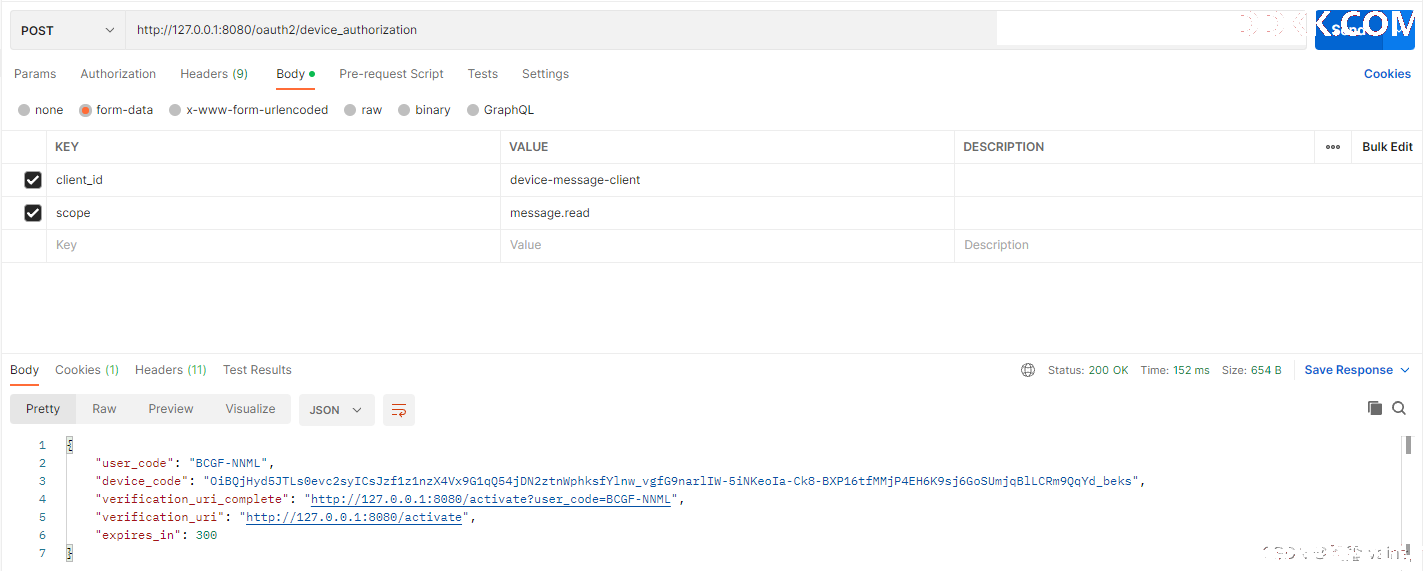
请求参数说明
client_id: 客户端id
scope: 设备请求授权的范围
响应参数说明
user_code: 用户在浏览器打开验证地址时输入的内容
device_code:设备码,用该值换取token
verification_uri_complete:用户在浏览器打开的验证地址,页面会自动获取参数并提交表单
verification_uri:验证地址,需要用户输入user_code
expires_in:过期时间,单位(秒)
访问verification_uri或者verification_uri_complete
未登录,跳转至登录页

输入user_code并提交

重定向至用户授权确认页面
该客户端用户尚未确认过,重定向至授权确认页面,勾选scope后提交
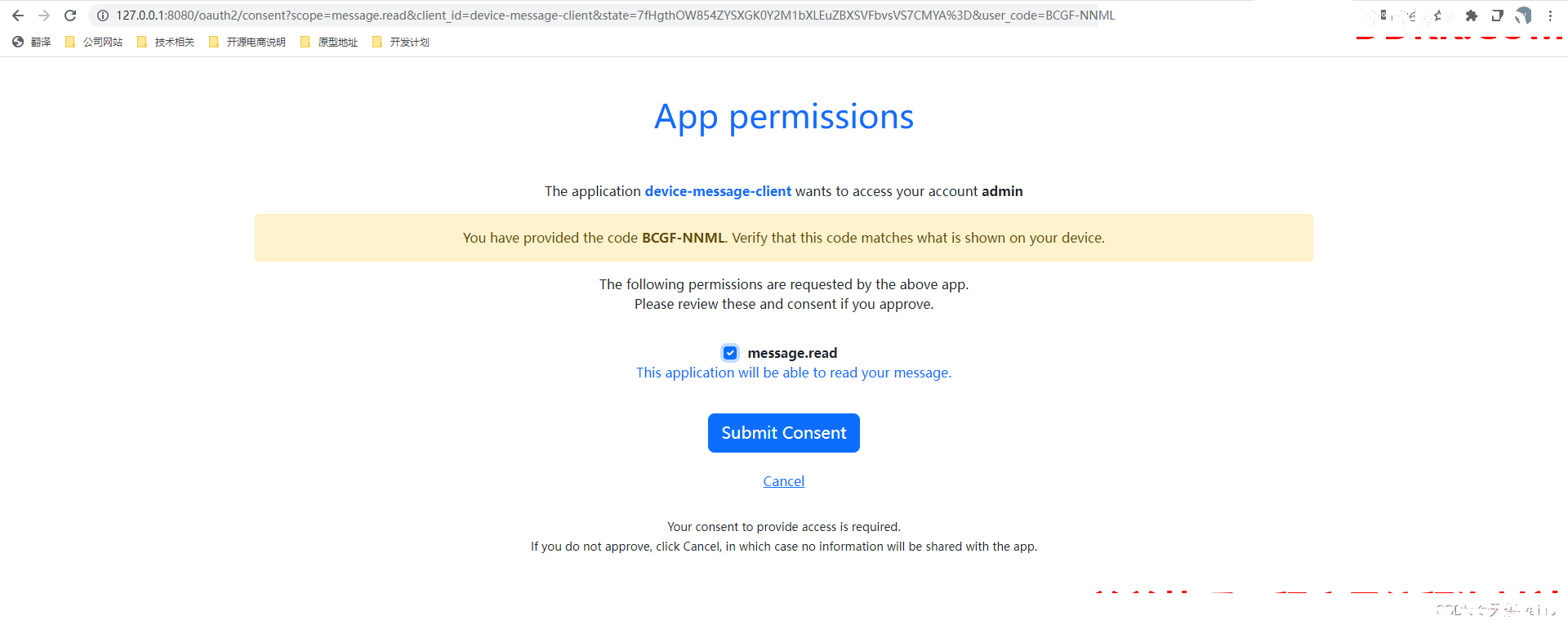
授权成功后跳转至成功页面

设备发起请求用设备码换取token,请求/oauth3/token接口
老样子,使用postman模拟设备请求
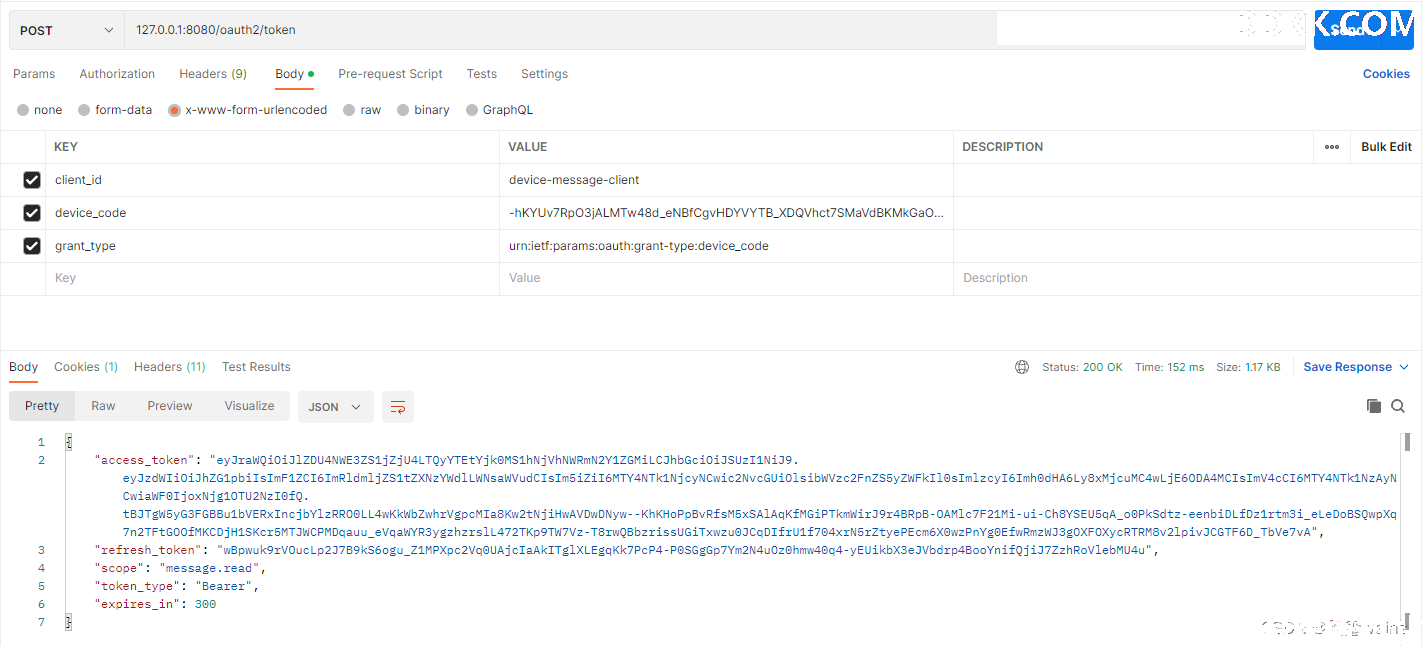
这里我是重新获取了一个,之前的过期了,使用过期设备码请求如下所示
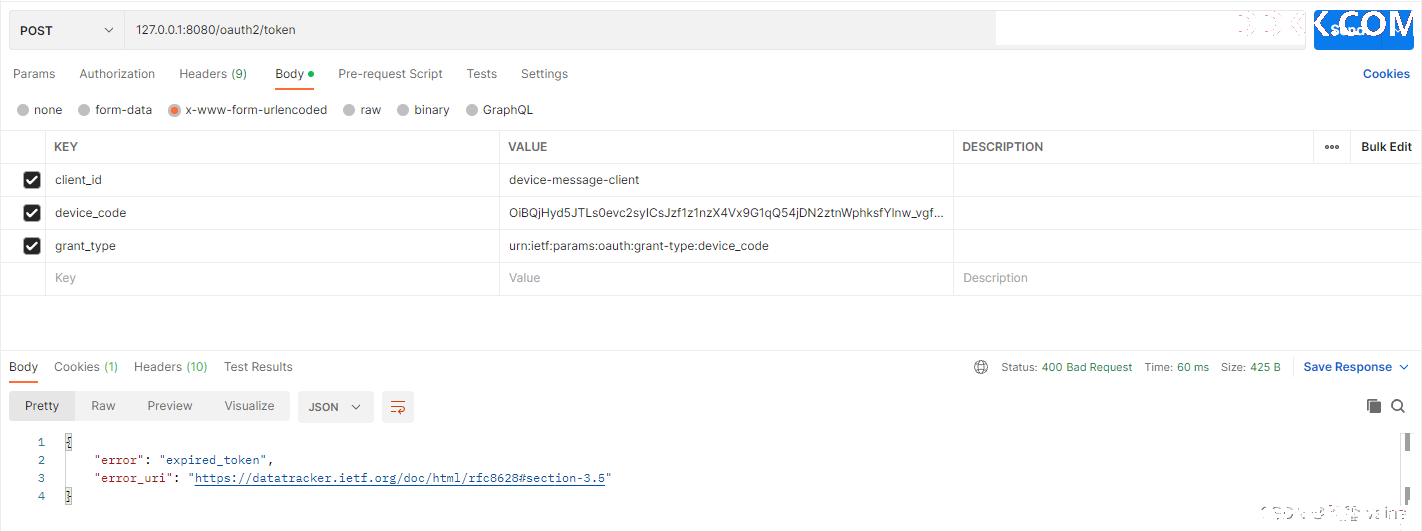
用户尚未验证时使用设备码请求如下
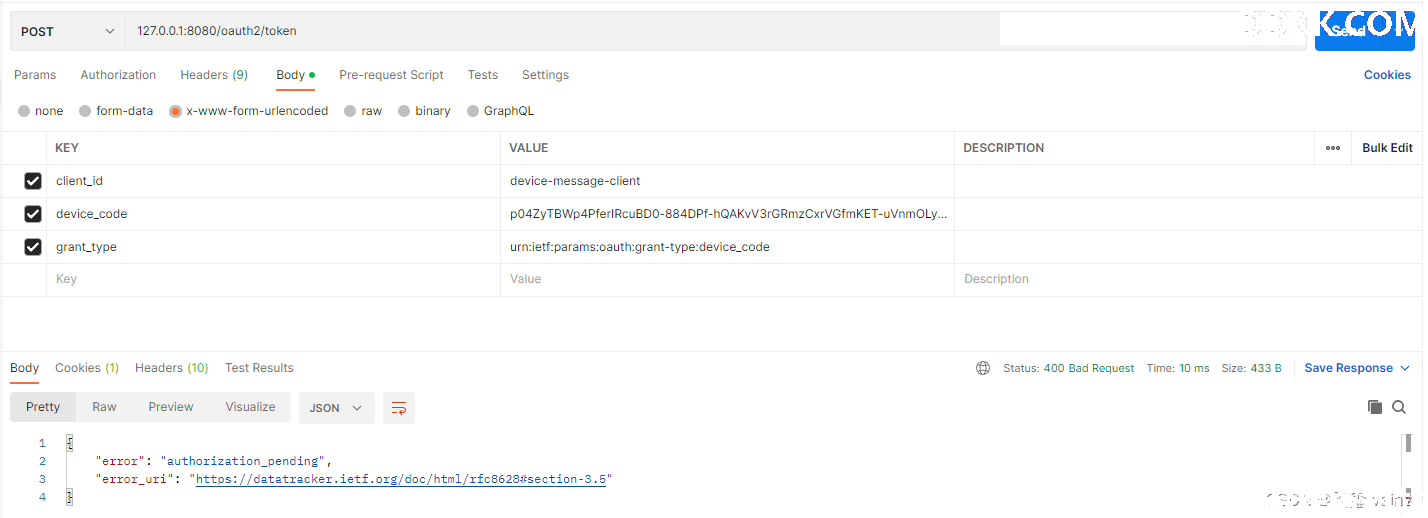
参数解释
client_id:客户端id
device_code:请求/oauth2/device_authorization接口返回的设备码(device_code)
grant_type:在设备码模式固定是urn:ietf:params:oauth:grant-type:device_code
至此,自定义设备码流程结束,项目结构如下图所示
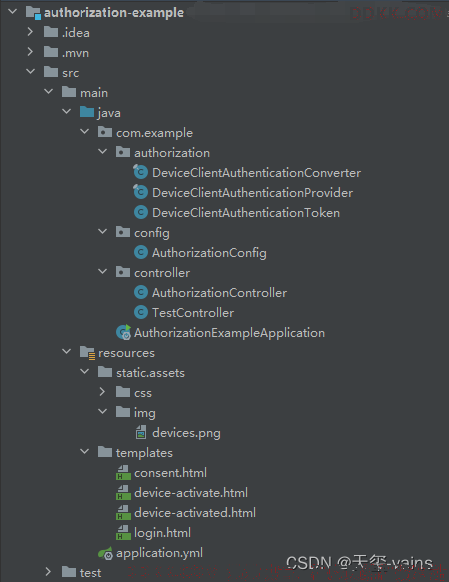
写在最后
设备码流程一般使用在不便输入的设备上,设备提供一个链接给用户验证,用户在其它设备的浏览器中认证;其它的三方服务需要接入时就比较适合授权码模式,桌面客户端、移动app和前端应用就比较适合pkce流程,pkce靠随机生成的Code Verifier和Code Challenge来保证流程的安全,无法让他人拆包获取clientId和clientSecret来伪造登录信息;至于用户登录时输入的账号和密码只能通过升级https来防止拦截请求获取用户密码。